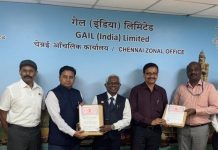[This Interview was published in the June 2022 issue of Chemical Industry Digest]
Plastics is a very versatile material with myriad advantages and benefits. However, its non-biodegradability and ubiquitous human practice of ‘throwaway’ has led to mammoth problem of plastics pollution on land to our waters to the seas and now with microplastics, even in the air.
To understand how this can be tackled Chemical Industry Digest had an interaction with Mark Vester, SABIC’s Global Leader for Circular Economy. He speaks of how circular polymers can mitigate this problem and how when combined with designing resins and products for circularity (along with end users) abinito this problem can be well addressed.
 Chemical Industry Digest (CID): Plastics were considered as wonder materials for their range and versatility, which led to multifarious applications – and ever increasing – in every field of human activity. However, today from plastics wastes in landfills, oceans, on earth to everywhere else, we have a problem of epic proportions. Is it only a problem of human carelessness in disposals? Or is it that in the rush to commercialize new materials (like plastics) our scientific community overlooked the disastrous consequences to human beings and the environment?
Chemical Industry Digest (CID): Plastics were considered as wonder materials for their range and versatility, which led to multifarious applications – and ever increasing – in every field of human activity. However, today from plastics wastes in landfills, oceans, on earth to everywhere else, we have a problem of epic proportions. Is it only a problem of human carelessness in disposals? Or is it that in the rush to commercialize new materials (like plastics) our scientific community overlooked the disastrous consequences to human beings and the environment?
Mark Vester (MV): The value that plastics bring to industry and humanity is tremendous. From serving as durable and hygienic packaging for food and medicines to being at the heart of consumer devices and transportation, plastics have – and will continue to play – an indispensable role in our lives.
There is no doubt that urgent steps are needed to address plastic pollution, a challenge compounded by the fact that recycling will not be enough and effective measures must be taken to ensure that plastics never end up in the landfills or our oceans but are instead reused and remade into valuable new products.
This shift to a circular economy, which is restorative and regenerative by design, helps maintain the value of plastics in the economy without impacting the natural environment. At SABIC, we are driving this model of production and consumption, which includes amongst other solutions, advanced recycling. This not only extends the lifecycle of products, but when the product reaches the end of its intended use, its materials can be kept within the circular economy for repeated use productively, creating further value.
CID: Is non-biodegradability the major challenge resulting in accumulation of plastics wastes? What are the developments related to biodegradable plastics? Can plastics be made greener? Are there any other major innovations on the horizon that can address the challenges of plastics wastes?
MV: Essentially, solution to the challenge of plastic wastes extends much beyond biodegradability of plastic. Therefore, it is safe to say that non-biodegradability is not the core issue. Recycling begins at the end of a product cycle therefore, shifting to the circular economy helps prevent waste and pollution. Several industries face difficulties in embracing the circular economy given the limited availability of recycled or renewable feedstocks. The growing demand for plastic cannot be met only through recycling or renewable feedstocks, which forces businesses to continue to use other resources, mainly fossil fuels. Yet, both recycling as well as renewable feedstocks can bring a substantial reduction in the footprint of plastics, which already in many applications have a footprint advantage over other materials.
Conventional plastic recycling is only suitable for a limited range of well-sorted plastic waste streams and has limitations in its application, thus, only less than 10 percent of the plastic waste is currently recycled, according to a recent report by Organisation for Economic Co-operation and Development. SABIC is helping to address the challenge through the development and launch of circular polymers, using advanced recycling processes to deal with used plastic that cannot be easily recycled with existing mechanical recycling processes.
The advantage of circular polymers, an innovation that can contribute to addressing the challenge of plastic waste, is that they have the same properties as the original material. They are high-quality, have excellent purity and can meet the stringent requirements for food contact packaging. They can help meet the demand of our customers for more sustainable products.
Our TRUCIRCLETM solutions play a significant part in closing the loop on used plastics and through this we provide manufacturers access to more sustainable materials, including mechanically recycled polymers, certified circular products, certified renewable products, products designed for recyclability and closed loop initiatives.
CID: As you are aware, manufacturing industries world over are under pressure due to problems of pollution, wastes, climate change etc. and consequent more and more stringent regulatory regimes to address such challenges in the shortest possible time frames. This has led to newer models of manufacturing being propagated – the most ‘idealistic’ being circular model of manufacturing or Cradle to Cradle (C2C) etc. What are the main elements of C2C? How practical it is for industries to adopt and transit from current linear manufacturing they practice? Are there more business opportunities industries can tap through C2C?
MV: We see the concept of Cradle to Cradle as complementary to our work on circularity. Transitioning from a linear to circular model requires, amongst other things, organizational commitment, which we demonstrate across our operations at SABIC.
For example, our certified circular polymers are produced using a pyrolysis oil feedstock from the recycling of used and mixed plastic. In this, plastic is heated at an elevated temperature in an oxygen-free environment, producing pyrolysis oil, which is further refined and upgraded for use as feedstock. This feedstock is then used to produces polymers that have identical properties to virgin fossil-based polymers, allowing plastics to be recycled repeatedly with no loss of properties or characteristics.
These finished circular products are supplied to our customers for a variety of applications, including certified food-contact packaging, personal and home care products, and healthcare – to name a few.
We are already using this alternative feedstock in our cracker in the Netherlands. SABIC and Plastic Energy are also building a new advanced recycling unit in the Netherlands to further increase the production of SABIC’s certified circular products from used plastics.
Another good example of how we are helping organizations re-use plastics effectively is our collaboration with UK retailer, Tesco. An entire supply chain has worked together to recycle plastic collected from Tesco customers into new food-grade packaging. To prove the closed loop concept, such collected flexible plastic material are converted into oil, through pyrolysis. This recycled oil was used by SABIC in the production process as an alternative to traditional fossil materials to make new plastic pellets that are as safe and effective as virgin plastic. The pellets are being used to make food packaging which meets all the performance requirements of packaged food suppliers.
CID: Can the plastics industry adopt C2C? Plastics are very recyclable material. So then what is the hitch in moving towards C2C? What should the industry be doing?
MV: The plastics industry is already heavily committed to driving a circular economy for plastics. In recent years, there has been an increasing demand to reduce plastic waste, stop the use of single-use plastics and take action to prevent plastic litter entering the environment.
Manufacturing circular plastics will help protect and enrich the environment and help further the circular economy approach. Manufacturers should also be given access to more sustainable materials so that they and the consumer can feel confident in products with plastic packaging, with the knowledge that the material can be recycled and repurposed.
Circular economy is the need of the hour since it ensures sustainable growth over time. Investing in C2C plastic and enabling the circular economy, we can drive the optimization of resources, reduce the consumption of raw materials, and recover waste by recycling the same.
Up to 80% of a product’s environmental impacts are determined at the design phase, so it is critical for manufacturers to work together with customers to design packaging solutions which can be recycled. This process should include a consideration towards reducing the complexity of materials and polymers used to create a specific product.
From an industry perspective, what is important is to demonstrate where plastics is the most appropriate material to be used and how it can be used responsibly.
CID: Industry has devised many different methods to address the challenges of wastes and pollution – from end of the pipe treatment to revisiting existing chemistries & products to optimize them, green chemistry etc. But as some environmental activists have opined these are only making the processes and products less bad – not good enough to address the challenges which are growing to epic proportions. What would you suggest: deploy a combination of all these or transit directly to circular manufacturing?
MV: Plastics have become the ubiquitous workhorse material of the modern economy – combining unrivalled functional properties with low cost. Their use has increased twentyfold in the past half-century and is expected to double again in the next 20 years. Today nearly everyone, everywhere, every day comes into contact with plastics. It has revolutionized our daily lives and several industrial sectors. It is widely present in our lives, from the beginning to the end, due to its practicality, convenience, and safety.
Despite the challenges in embracing the circular economy, organizations can adopt a circular business model in many ways. One way is to keep in mind the products in use – whether you are designing new products or packaging, think durability, recyclability, and re-use to keep components and their circularity in the economy.
Another way is to ensure use of tailored resins for the development of products that have improved recyclability characteristics and to produce plastics and polymers using renewable feedstock or feedstock recycling as well as decarbonization efforts in the value chain.
There is no one-size-fits-all approach to embracing circularity and it is the responsibility of organizations to explore diverse streams to achieve their desired goals.
Our state-of-the-art SABIC Technology Center (STC) in Bengaluru, India, is conducting innovative research into new platforms for future proofing innovative solutions for circular economy in general and across industries such as Construction, Clean Energy, Electrics and Electronics, Medical Devices, Transportation and more.
CID: To what extent can the suite of emerging digital technologies – Industry 4.0 – from IIoT to Machine Learning to AI etc. enable circular manufacturing?
MV: Of course, digital technologies play a significant role in pivoting to the circular economy. At SABIC, we are leveraging our resources and expertise to develop products that meet the needs of the circular economy and are investing heavily in digitalization and artificial intelligence (AI) solutions to support our overall value chain. More specifically we are investigating how for example blockchain can help accelerate the introduction of a transparent circular plastic value chain.
We were the first in the industry to offer a renewable and later circular polymer based on International Sustainability and Carbon Certification (ISCC) PLUS. We are collaborating with partners upstream and down to reinvent our way into a circular economy—and make sure used plastic never ends up in the environment, landfills, or in our oceans and instead is reused and remade into valuable new products.































